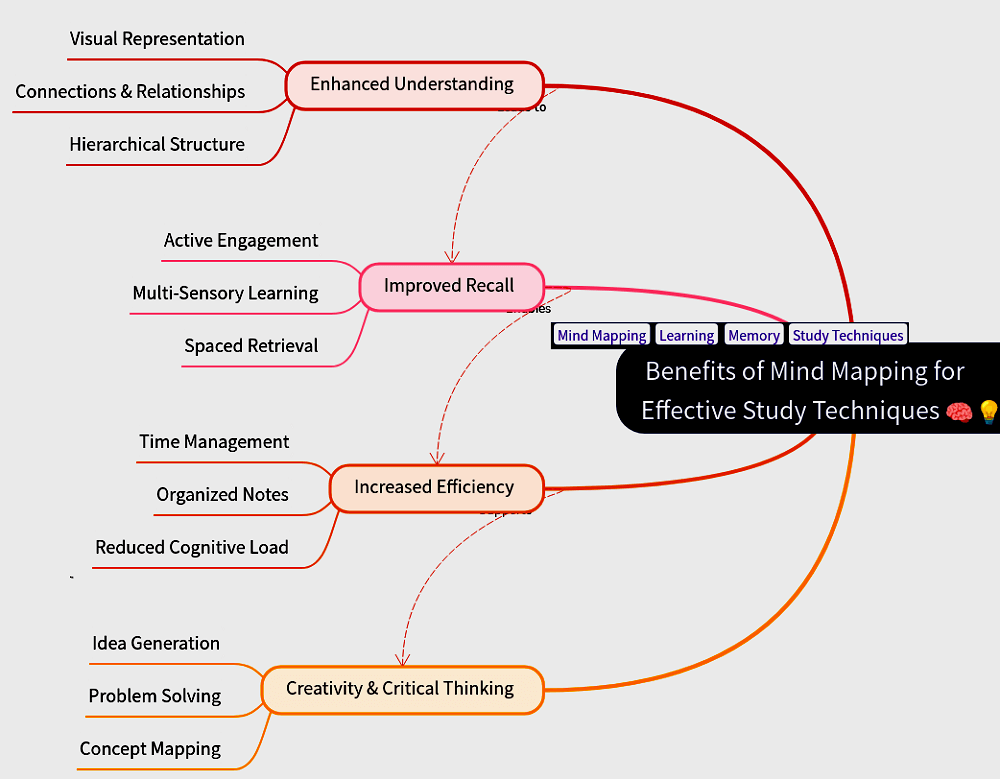
Exploring the Benefits of Mind Mapping for Effective Study Techniques
Mind mapping is an incredibly versatile tool that has gained popularity as an effective study technique, enabling students to organize complex information visually. This method not only helps in improving memory retention but also enhances creativity, problem-solving, and comprehension. In this article, we will explore the benefits of mind mapping, practical steps to implement it, and how it can transform the way you study.
What is Mind Mapping?
Mind mapping is a visual diagram that allows you to organize information in a non-linear fashion. Unlike traditional note-taking methods, where information is recorded in a linear, text-heavy format, mind maps focus on branching ideas from a central concept. This makes it easier to connect and process related information quickly. Mind mapping mimics the brain’s natural way of thinking, enabling you to understand and recall information more effectively.
Why Mind Mapping is Effective for Studying
Mind mapping offers several key benefits that make it ideal for studying:

1. Enhances Memory Retention
Mind maps use colors, images, and keywords to create visual cues that help the brain retain information. Studies have shown that visual elements play a crucial role in enhancing memory recall, as the brain processes visuals faster than text. By associating ideas with images and colors, students can better remember details, making revision more efficient.
2. Encourages Creativity and Problem-Solving
The open structure of mind maps fosters creativity. Instead of sticking to rigid formats, students are free to explore different connections between ideas. This creative approach can lead to better problem-solving, as it encourages students to think beyond linear boundaries and examine topics from multiple angles.
3. Improves Focus and Organization
Mind maps force you to distill information into concise keywords, making it easier to focus on the core aspects of a subject. The hierarchical structure of mind mapping ensures that you prioritize key points over less relevant information, preventing you from getting lost in unnecessary details.
4. Promotes Active Learning
Creating a mind map is an active process. As you generate and organize ideas, you engage with the material on a deeper level, which improves your understanding of the subject. Active learning techniques like this have been shown to be more effective than passive learning, where students merely absorb information without interaction.
How to Use Mind Mapping for Effective Study Techniques
Now that we’ve covered the benefits of mind mapping, let’s look at how you can start incorporating it into your study routine.
Step 1: Choose a Central Topic
Start with the main concept or subject you are studying. This will be the central node from which all other ideas will branch. Write the central topic in the middle of the page, using a bold color or image to make it stand out. For instance, if you are studying biology, your central topic could be "Cell Structure."
Step 2: Create Branches for Subtopics
From the central node, create branches that represent the key subtopics. For a topic like cell structure, you could create branches for the nucleus, mitochondria, cell membrane, and so on. Each subtopic should be clearly labeled with a keyword or short phrase.
Step 3: Add Further Details
Once you have established the main branches, add more layers of information. For example, under the branch for "Nucleus," you could add smaller branches for "Nuclear Membrane," "Chromatin," and "Nucleolus." The goal is to break down complex information into manageable pieces.
Step 4: Use Colors, Images, and Keywords
Enhance your mind map with colors and images that help make information easier to recall. Different colors can represent different categories of information, while images can serve as visual reminders. Keep your text limited to keywords rather than full sentences to ensure that your mind map remains concise and focused.
Step 5: Review and Revise
After creating your mind map, review it regularly to reinforce the information. Mind maps are flexible and can be updated as you learn new information or make new connections. This iterative process helps solidify your understanding of the subject matter.
Tools for Creating Mind Maps
There are several digital tools available that can help you create detailed mind maps quickly and efficiently:
- XMind: A user-friendly mind mapping tool that offers a variety of templates and styles.
- MindMeister: Allows for collaborative mind mapping, making it ideal for group study sessions.
- SimpleMind: A flexible and easy-to-use app that is perfect for beginners.
These tools provide a variety of features such as color-coding, icons, and hierarchical structures that enhance the visual impact of your mind maps.
Scientific Evidence Supporting Mind Mapping
Research in cognitive psychology supports the use of visual aids like mind maps to enhance learning. A study conducted by the University of London found that students who used mind mapping showed a significant improvement in both memory recall and comprehension compared to those who used traditional note-taking methods. This is because mind maps engage multiple cognitive functions, including visual, spatial, and linguistic processing, which leads to more robust learning.
Moreover, another study published in the Journal of Educational Psychology demonstrated that students who actively created mind maps retained 20% more information than those who passively reviewed pre-existing notes. This emphasizes the active learning aspect of mind mapping as a powerful tool for improving academic performance.
Common Challenges and Solutions When Using Mind Mapping
Although mind mapping offers many benefits, students may face a few challenges when starting. Here are some common issues and their solutions:
1. Overcomplicating the Mind Map
Students may be tempted to include too much detail, which defeats the purpose of simplifying information. To avoid this, focus on using keywords and limit each branch to 2-3 subpoints. Remember, the goal is clarity, not complexity.
2. Difficulty in Choosing Keywords
Choosing the right keywords can be challenging. To overcome this, think of keywords as triggers that will help you recall more detailed information. If a keyword doesn’t instantly remind you of the associated content, revise it.
3. Struggling with Visual Design
Not everyone is naturally skilled at creating visually appealing diagrams. Start simple and gradually build your mind mapping skills. You can also use digital tools with built-in design templates to help with aesthetics.
Real-World Applications of Mind Mapping
Mind mapping isn’t just limited to academic study; it has applications across various fields. For instance:
- Business Planning: Professionals use mind maps to brainstorm ideas, organize projects, and develop business strategies.
- Writing and Creativity: Writers and artists use mind maps to outline plots, develop characters, and generate ideas.
- Personal Development: Individuals use mind maps for goal setting and problem-solving in their personal lives.
These versatile applications show that mind mapping is a skill that extends beyond the classroom, offering lifelong benefits.
Conclusion: Why You Should Start Mind Mapping Today
Mind mapping is a powerful, adaptable tool that can significantly enhance your study techniques. By helping you organize and retain information more effectively, mind mapping boosts your academic performance, improves problem-solving skills, and encourages active learning. With its visual and creative approach, this method aligns with the brain's natural processing power, leading to better comprehension and long-term retention.
If you're looking to enhance your study habits, increase focus, and achieve better results in your academic pursuits, mind mapping is an excellent place to start. Don’t wait—begin experimenting with mind mapping today and experience its transformative power in your learning journey.
Call to Action
Ready to try mind mapping? Start by creating a mind map for your next study session and see the difference it can make. If you found this article helpful, feel free to share it with your friends or leave a comment below to share your experience with mind mapping!
Study Tips Life Skills Students

